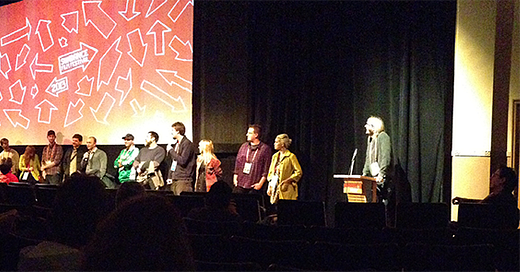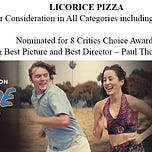My first Sundance was January 1991.
I wish I could say I was there for Sex, Lies & Videotape in 1989. I was convinced that I was for a while. But now I am pretty sure it was 2 years after, in the wake of that film and Miracle Mile and Heathers.
I went to Park City without any idea of what I was getting into, except that cool stuff was happening at this festival. I got a room at The Yarrow at the last minute. I called them from L.A. Gave them my credit card number over the phone. Or maybe they just took the reservation without a card... the good old days.
I don’t think I bought any tickets until I was there. I remember seeing American Dream and Paris is Burning and Blood in the Face and Thank You & Good Night and Slacker and Straight Out of Brooklyn and Christo in Paris and Trust. I’m not even sure I got to the Eccles that year. I mostly stuck to the Yarrow-adjacent and doc-rich Holiday Village and the Egyptian on Main Street. Didn’t have a car. I ate most of my meals on Main Street, at the late, great Texas Red’s and the breakfast place at the top of the hill.
I was 26. And seeing those films in those theaters brings clear memories to this day. I still talk often about the audience for Blood in the Face, some of whom were enraged that the doc that got access to neo-Nazis wasn’t more objectively clear about Nazis being evil. Oy. 31 years later, well-intended people on both sides of the political spectrum are still making that kind of idiotic argument.
The most memorable thing about the festival was buying a ticket to see Robert Altman, live and in person, and seeing him at the bar in the middle of Main Street, where I would later watch the Super Bowl, and where concerts still happen each year, with about 50 other people, all of us, Altman included, on crappy folding chairs. The intimate access to a cinema master was shocking. And wonderful.
I went again, on my own, in 1992 and 1993. In 1995 and 1996, I think I got some newspapers to pay for the trip. In 1997, I remember the awards event, which I think I hadn’t been invited to before. Hurricane Streets. In 1999, I started going for roughcut.com, with an increasingly large crew. I think that was the first year where I saw every film in competition.
I took 6 years off from the festival, from 2014 -2019. My business, Movie City News, was spending a lot of money to take a crew of 6 - 8 people up there every year for the previous decade, with at least 3 film critics and a camera crew each year. Frankly, I felt the festival was not taking reasonable care of me and my team. We weren’t festival sponsors. But we had a big footprint and we were being taken for granted.
I was ushered back into the fold in 2020 by a new member of the Sundance team. Thankful for that. It was in the intense heat of COVID. And I was happy to be able to rejoin the festival for the part that was really important to me… the movies.
Roget Ebert, who was a loyal, loyal guy and whose loyalty extended to Cannes, then Toronto, then Sundance, used to say that the only problem with Sundance was all the snow. Why should we slog around all that weather? It made no sense. But he did it. He did it in health and in sickness.
In 1999, there was a major turn at Sundance. Many indie hits had come out at the festival in the decade since Sex, Lies’ 1989 debut. But 1999 would be the Sundance of The Blair Witch Project and Happy, Texas, two festival landmarks representing the best and worst case scenarios.
Blair Witch, whatever you think of the film, was really unknown filmmakers, doing a kind of film that had not been done much since the 60s, using then-new equipment, using new publicity techniques for the festival itself. It became a quick bidding war and a big hit and everyone thought it was the trendsetter for the next period.
Happy, Texas, on the other hand, was a nice little quirky comedy that got way overpaid for by The Weinsteins and became the codename for Sundance hysteria and price bloat… until Hamlet 2, a nice little quirky comedy with a big league comedy director and a cool young cast and everyone’s hopes that Steve Coogan was the next big thing in comedy beyond the U.K.. It got an even bigger boneheaded buy from Focus in 2008 and became the new symbol of a Sundance misstep.
There was a time when the marketing around Sundance seriously threatened the legitimacy of the festival. In the 80s and into the 90s, Main Street was the same Main Street you would find if you were on vacation anytime in Park City. In the 90s, the swag houses started to build up, but most of them were in Deer Valley, requiring an invitation and a car to get there. Increasingly, there were events where you would need to go to one location to get an invitation to go to another place to get an invitation and the punchline was finding the place and having the secret code to get past the gates.
Alex Mamlet and Amir Bar-Lev created a character named Kid Protocol when TIFF did a series of shorts with attending filmmakers for their 25th anniversary. 4 months later, in January 2001, roughcut.com supported Kid Protocol 2, an 8-minute short on party-crashing efforts at Sundance. (Alex posted a combination of the 2 shorts on Vimeo. Our part starts at about 6 minutes)
The intensity of the non-film scene at Sundance was so extreme, we also had a full-time party reporter for that year’s festival. (She brought all the boys to the yard… not sure I’d do that again.)
Just a few years later, Paris Hilton became the living symbol of everything that was wrong with Sundance. Half the businesses on Main Street were taken over by sponsors and it became hard to find lunch without being on someone’s list.
Sundance, as an organization, did its darndest to shut down the hysteria. When the gifting suites were in houses in Deer Valley, that was one thing. When they were eating Main Street alive, it was another.
But the town wanted the money from the marketers. And Sundance girded itself, refocused on what its mission is, and like a Dr. Seuss book, something miraculous happened.
Sundance bifurcated.
The people who cared about the movies found their lane. The people who cared about the parties found their lane.
And with the expansion to include worldwide cinema in competition, taking it from one dramatic and one doc to two each, even the people who were there for the cinema bifurcated again. There are 40 competition slots and no one can cover all of them, even ignoring the other sections completely.
The wider range of films somehow refocused the energy back towards the films themselves. There was still all the partying and hype…but the people who were there for that got that. The people who were there for the films may have felt left out sometimes, but they had something better to do with their week.
The era of The Streamer at Sundance has changed things in a certain way… but less, really, than you might expect. Just as in “the real world,” the streamers don’t know the value of money.
Last year’s record $25 million buy of CODA, for instance. That figure makes a legacy window release of the film pretty much a guaranteed loser, financially. But Apple had a different set of reasons for wanting CODA. It was a symbolic buy. It was a bow to the deaf community and Apple’s support of said community. I’m not saying they don’t love the movie. But it wasn’t about making money by buying the movie.
The reality for streamers in 2021 is that television programming costs them between $6 million and $15 million an hour these days. At Sundance, they get to see the finished movies and the most expensive buy ever, CODA, is essentially $12.5 million an hour. It’s on the high end of spending… but it’s not by any means insane.
Summer of Soul was another variation in the new models. The price was said to be over $12 million, setting a new record for docs. Couldn’t have cost more than $3 million - probably a lot less - so the filmmakers/producers were swimming in success. The film was released day-n-date by 2 Disney divisions, Searchlight and Hulu. It did $2.3 million in domestic theatrical. It brought Hulu eyeballs, but even more so, prestige. And it is still looking at the Best Doc Oscar as a strong possibility sometime in the spring, whenever the hell Oscar is this year…. before Easter… after Easter… who knows?
But the obsession with dollar figures at Sundance has always been the lowest form of Sundance coverage. As a market, it is absolutely critical… but not because of the cash flow. It’s the movies, stupid.
2021 was a little flat. Some great films, but they haven’t really busted through commercially. But 2020? Minari, Palm Springs, The 40-Year-Old Version, and Zola have all had impact from that year’s dramatic competition. Docs Boys State, A Thousand Cuts, Crip Camp, Dick Johnson Is Dead, The Fight, Time, and Welcome To Chechnya led a great group.
Some of these films would have found an audience anyway. But some would not have.
What people who don’t cover or attend Cannes are often misinformed about is the fact that the Cannes Market is really quite separate from the Film Festival and its films in competition. Yes, some of the competition films get bought out of Cannes… though mostly for the United States, having financed themselves to completion with sales to other countries (sometimes including the U.S.). Most of what is the market at Cannes is about making deals for the next year or two of films and selling territories for existing or near-existing films. The marriage of the high brow and the low brow works nicely for both sides.
The market story out of Sundance is part of the importance of Sundance. But the primary importance is that there is a parade of new films, most by new filmmakers, that have a platform to be seen by the industry and the media and, by extension, the world.
While there is a level of convenience in watching Sundance on our TVs at home, that isn’t the best Sundance experience for writers who love movies. Because our community is getting the opportunity to share it all as well when we are together in Park City. I have seen the best of people and the worst of people in Park City. I have had movie moments that will never be quite the same anywhere else. I have had sexless intimacies with people who showed themselves or saw me in a way that no other circumstance demanded.
And I have all those memories of the movies and the filmmakers. Seeing Napoleon Dynamite for the first time. Or that first screening of Blair Witch. Or Born Into Brothels. Or that first screening of Precious. Or the crew from Humpday all on one couch in our rental house. Or almost getting into a fist fight with the normally restrained James Rocchi over Upstream Color. Or unnamed movie star missing the bowl and peeing on our bathroom floor. Or Zoo!!! Or Thin. Or Pussy Riot, live from Russia after the doc about them. Or recreating the Yarrow restuarant fight between Jeff Dowd and John Anderson with Michael Jai White playing Anderson. Or George Romero sitting with me and chatting. Or being within feet of the emotions of filmmakers and actors receiving the love and support of an audience for the first time… so many times. And so much more.
Everything that was and is so difficult about Sundance is a part of what is great about Sundance. To overcome hurdles and then to experience great work… it is all the greater.
Maybe that is part of the Sundance Brain Damage that occurs when some movies get hyped to the heavens. But I think that is really more like the phenomenon of paying a ton for Broadway show tickets and giving a standing ovation to whatever show because you paid so much to attend. Heck… maybe those two phenomena are similar. But it’s not just Sundance. In many ways, Cannes is worse. People HATE or LOVE and given a short cooling off period, passions cool. But the thing at Sundance is to convert those passions into a deal asap, giving no one a chance to cool down.
I love Sundance. I get why some people hate it… or find it irritating… or too much. I feel that way sometimes too. But mostly… because of the movies… love.
Until tomorrow…



















Share this post